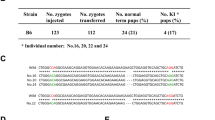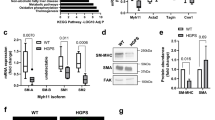Abstract
We have recently described two kindreds presenting thoracic aortic aneurysm and/or aortic dissection (TAAD) and patent ductus arteriosus (PDA)1,2 and mapped the disease locus to 16p12.2-p13.13 (ref. 3). We now demonstrate that the disease is caused by mutations in the MYH11 gene affecting the C-terminal coiled-coil region of the smooth muscle myosin heavy chain, a specific contractile protein of smooth muscle cells (SMC). All individuals bearing the heterozygous mutations, even if asymptomatic, showed marked aortic stiffness. Examination of pathological aortas showed large areas of medial degeneration with very low SMC content. Abnormal immunological recognition of SM-MHC and the colocalization of wild-type and mutant rod proteins in SMC, in conjunction with differences in their coimmunoprecipitation capacities, strongly suggest a dominant-negative effect. Human MYH11 gene mutations provide the first example of a direct change in a specific SMC protein leading to an inherited arterial disease.
This is a preview of subscription content, access via your institution
Access options
Subscribe to this journal
Receive 12 print issues and online access
$209.00 per year
only $17.42 per issue
Buy this article
- Purchase on Springer Link
- Instant access to full article PDF
Prices may be subject to local taxes which are calculated during checkout





Similar content being viewed by others
Accession codes
References
Glancy, D.L., Wegmann, M. & Dhurandhar, R.W. Aortic dissection and patent ductus arteriosus in three generations. Am. J. Cardiol. 87, 813–815 (2001).
Khau Van Kien, P. et al. Familial thoracic aortic aneurysm/dissection with patent ductus arteriosus: genetic arguments for a particular pathophysiological entity. Eur. J. Hum. Genet. 12, 173–180 (2004).
Khau Van Kien, P. et al. Mapping of familial thoracic aortic aneurysm/dissection with patent ductus arteriosus to 16p12.2-p13.13. Circulation 112, 200–206 (2005).
Coady, M.A. et al. Familial patterns of thoracic aortic aneurysms. Arch. Surg. 134, 361–367 (1999).
Vaughan, C.J. et al. Identification of a chromosome 11q23.2-q24 locus for familial aortic aneurysm disease, a genetically heterogeneous disorder. Circulation 103, 2469–2475 (2001).
Guo, D. et al. Familial thoracic aortic aneurysms and dissections: genetic heterogeneity with a major locus mapping to 5q13–14. Circulation 103, 2461–2468 (2001).
Hasham, S.N. et al. Mapping a locus for familial thoracic aortic aneurysms and dissections (TAAD2) to 3p24–25. Circulation 107, 3184–3190 (2003).
Pannu, H. et al. Mutations in transforming growth factor-beta receptor type II cause familial thoracic aortic aneurysms and dissections. Circulation 112, 513–520 (2005).
Hoffman, J.I. & Kaplan, S. The incidence of congenital heart disease. J. Am. Coll. Cardiol. 39, 1890–1900 (2002).
Satoda, M. et al. Mutations in TFAP2B cause Char syndrome, a familial form of patent ductus arteriosus. Nat. Genet. 25, 42–46 (2000).
Mani, A. et al. Finding genetic contributions to sporadic disease: a recessive locus at 12q24 commonly contributes to patent ductus arteriosus. Proc. Natl. Acad. Sci. USA 99, 15054–15059 (2002).
Babu, G.J., Warshaw, D.M. & Periasamy, M. Smooth muscle myosin heavy chain isoforms and their role in muscle physiology. Microsc. Res. Tech. 50, 532–540 (2000).
Straussman, R., Squire, J.M., Ben-Ya'acov, A. & Ravid, S. Skip residues and charge interactions in myosin II coiled-coils: implications for molecular packing. J. Mol. Biol. 353, 613–628 (2005).
Franke, J.D., Dong, F., Rickoll, W.L., Kelley, M.J. & Kiehart, D.P. Rod mutations associated with MYH9-related disorders disrupt nonmuscle myosin-IIA assembly. Blood 105, 161–169 (2005).
Meredith, C. et al. Mutations in the slow skeletal muscle fiber myosin heavy chain gene (MYH7) cause laing early-onset distal myopathy (MPD1). Am. J. Hum. Genet. 75, 703–708 (2004).
Laurent, S., Boutouyrie, P. & Lacolley, P. Structural and genetic bases of arterial stiffness. Hypertension 45, 1050–1055 (2005).
Slomp, J. et al. Differentiation, dedifferentiation, and apoptosis of smooth muscle cells during the development of the human ductus arteriosus. Arterioscler. Thromb. Vasc. Biol. 17, 1003–1009 (1997).
Morano, I. et al. Smooth-muscle contraction without smooth-muscle myosin. Nat. Cell Biol. 2, 371–375 (2000).
Hornblad, P.Y. Studies on closure of the ductus arteriosus. 3. Species differences in closure rate and morphology. Cardiology 51, 262–282 (1967).
Meloni, I. et al. Pseudoxanthoma elasticum: point mutations in the ABCC6 gene and a large deletion including also ABCC1 and mYH11. Hum. Mutat. 18, 85 (2001).
Ching, Y.H. et al. Mutation in myosin heavy chain 6 causes atrial septal defect. Nat. Genet. 37, 423–428 (2005).
Geisterfer-Lowrance, A.A. et al. A molecular basis for familial hypertrophic cardiomyopathy: a beta cardiac myosin heavy chain gene missense mutation. Cell 62, 999–1006 (1990).
Boileau, C., Jondeau, G., Mizuguchi, T. & Matsumoto, N. Molecular genetics of Marfan syndrome. Curr. Opin. Cardiol. 20, 194–200 (2005).
Nachtigal, M., Nagpal, M.L., Greenspan, P., Nachtigal, S.A. & Legrand, A. Characterization of a continuous smooth muscle cell line derived from rabbit aorta. In Vitro Cell. Dev. Biol. 25, 892–898 (1989).
Bradford, M.M. A rapid and sensitive method for the quantitation of microgram quantities of protein utilizing the principle of protein-dye binding. Anal. Biochem. 72, 248–254 (1976).
Laemmli, U.K. Cleavage of structural proteins during the assembly of the head of bacteriophage T4. Nature 227, 680–685 (1970).
Quevillon-Cheruel, S., Foucault, G., Desmadril, M., Lompre, A.M. & Bechet, J.J. Role of the C-terminal extremities of the smooth muscle myosin heavy chains: implication for assembly properties. FEBS Lett. 454, 303–306 (1999).
Lupas, A., Van Dyke, M. & Stock, J. Predicting coiled coils from protein sequences. Science 252, 1162–1164 (1991).
Lalande, A. et al. Automatic determination of aortic compliance with cine-magnetic resonance imaging: an application of fuzzy logic theory. Invest. Radiol. 37, 685–691 (2002).
Aikawa, M. et al. Human smooth muscle myosin heavy chain isoforms as molecular markers for vascular development and atherosclerosis. Circ. Res. 73, 1000–1012 (1993).
Acknowledgements
We thank all the affected individuals and their families participating in this study. We thank the clinical research groups of Dijon University Hospital, the Conseil Régional de Bourgogne, the Fondation pour la Recherche Médicale, the Association Claude Bernard, the Leducq Foundation for their support. Experiments have also benefited from the facilities of the Institut de Biologie at the Collège de France and the Institut Federatif de Recherche at Faculté Bichat. We also thank C. Delaloy, E. Etienne, J. Hadchouel, J. Favier, O. Meilhac, A.M. Houot, L. Muller, C. Pouzet for technical help and advice, M. David for surgical aortic samples and M.-T. Zabot for primary cultures of fibroblasts. P. Khau Van Kien was funded by the Association de Cardiologie de Bourgogne. L. Zhu was funded by the Association Claude Bernard and then by the Programme Charcot of the French Foreign Ministry.
Author information
Authors and Affiliations
Corresponding author
Ethics declarations
Competing interests
The authors declare no competing financial interests.
Supplementary information
Supplementary Table 1
Characteristics of the 16 relatives with MYH11 mutation. (PDF 20 kb)
Supplementary Table 2
Characteristics of the 33 relatives without MYH11 mutation. (PDF 19 kb)
Rights and permissions
About this article
Cite this article
Zhu, L., Vranckx, R., Van Kien, P. et al. Mutations in myosin heavy chain 11 cause a syndrome associating thoracic aortic aneurysm/aortic dissection and patent ductus arteriosus. Nat Genet 38, 343–349 (2006). https://doi.org/10.1038/ng1721
Received:
Accepted:
Published:
Issue Date:
DOI: https://doi.org/10.1038/ng1721
This article is cited by
-
Diagnosis and treatment of cardiovascular disease in patients with heritable connective tissue disorders or heritable thoracic aortic diseases
Cardiovascular Intervention and Therapeutics (2024)
-
Genetics and mechanisms of thoracic aortic disease
Nature Reviews Cardiology (2023)
-
Aortic aneurysms: current pathogenesis and therapeutic targets
Experimental & Molecular Medicine (2023)
-
A harmful MYH11 variant detected in a family with thoracic aortic dissection and patent ductus arteriosus
Forensic Science, Medicine and Pathology (2023)
-
An integrated study fusing systems biology and machine learning algorithms for genome-based discrimination of IPF and NSIP diseases: a new approach to the diagnostic challenge
Soft Computing (2023)



